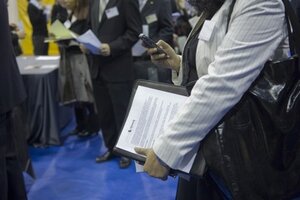US Economy is shifting, but toward what?
As during the Great Depression, when agriculture was in permanent decline, the US economy is in a period of transition. It remains to be seen what it's transitioning toward.

Job seekers attend a job fair at Pace University in New York on Jan. 22. As during the Great Depression, the US economy is seeing a shift in employment opportunities.
Frances M. Roberts/Newscom/file
This afternoon, your editor’s aging aunt called from Pennsylvania.
“This economy has been very hard on my family,” she explained. “I’ve got two sons-in-law…and they’re both laid off from their jobs.”
“What do they do?” we wondered.
“One drives a truck for a steel producer. The other is in construction. There’s just not much work, I guess.”
Nope.
And that’s why, despite all the recovery talk, real people are turning real gloomy. Consumer confidence just registered its lowest reading since 1983. People don’t have jobs…and they’re beginning to worry that it could be a long time before they work again. Mortgage demand just fell to its lowest point in 13 years. State tax receipts are still falling – for the 5th quarter in a row. And the number of problem banks just rose 27%.
Recovery? Forget it. There is no real recovery. This depression has to run its course, like it or not.
You’ve heard us say that a depression is a period of transition from one economic model to another. You might ask: what’s an economic model? And what economic model are we leaving behind? What economic model are we going towards? And what’s this got to do with monetary and fiscal stimulus?
Good thing you didn’t ask those questions before. We didn’t have any answers. But here is David Goldman with a partial explanation:
“There is some analogy to the Great Depression in the present situation. Between 1918 and 1939, American agriculture was in permanent decline, because the end of the First World War reduced demand for American exports, and because the substitution of the tractor for draught animals freed up an enormous amount of land set aside for animal feed. There was nothing to be done but to get the farmers off the land into other occupations, and that was not accomplished until the Second World War.”
The farmers found work in wartime factories…and in military service. After the war, they took up new jobs, in a new economy with new factories and new professions.
What work will today’s laid-off construction workers find? Darned if we know.
Add/view comments on this post.
------------------------------
The Christian Science Monitor has assembled a diverse group of the best economy-related bloggers out there. Our guest bloggers are not employed or directed by the Monitor and the views expressed are the bloggers' own, as is responsibility for the content of their blogs. To contact us about a blogger, click here. To add or view a comment on a guest blog, please go to the blogger's own site by clicking on the link above.
